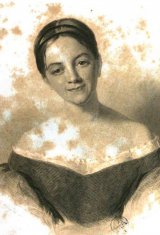Analysis of The Tomb of Aurungzebe
Letitia Elizabeth Landon 1802 (Chelsea) – 1838 (Cape Coast)
Oh, fleeting honours of the dead,
Oh, high ambition lowly laid.”
“A MIGHTY tomb, fit for a mighty king,
One last great mockery, a thousand slaves
Dug marble from the quarry, then arose
The slow foundation—men put forth their skill
In rich devices, and in ornament,
Then towered the rounded column, and the walls
Shone with red gold and many-coloured stones.
Then spread the broidered purple for a pall,
And all for what ?—to hide some grains of dust.”
So might the cynic say; so say not I.
It is a glorious thing for man to war
With time, by some great work. Wherefore was skill,
And energy, and industry, bestowed,
If that he use them not ? How many hearts
In the completion of this building throbbed
With the fine pride of art—that pride which leads
To all that can redeem or civilize
Our human nature. Now, what solemn thoughts
Brood here ! an atmosphere from which we draw
Such lessons as the dead alone can give,
And only they when present to the mind,
As they are present in this monument—
Oh, build tombs for the dead, they're mightier there
Than in their living palaces !
| Scheme | AX XXXBCXXXXXXBXXAXXXXXXCXX |
|---|---|
| Poetic Form | |
| Metre | 1101101 11010101 0101110101 1111000101 1101010101 0101011111 0101000100 11001010001 1111010101 110110101 0111111111 1101011111 11010011111 111111111 0100010001 1111111101 0001011101 1011111111 111101110 10101011101 111101111 1101010111 0101110101 1111001100 11110111001 10110100 |
| Closest metre | Iambic pentameter |
| Characters | 1,068 |
| Words | 197 |
| Sentences | 10 |
| Stanzas | 2 |
| Stanza Lengths | 2, 24 |
| Lines Amount | 26 |
| Letters per line (avg) | 32 |
| Words per line (avg) | 8 |
| Letters per stanza (avg) | 421 |
| Words per stanza (avg) | 99 |
Font size:
Citation
Use the citation below to add this poem analysis to your bibliography:
Style:MLAChicagoAPA
"The Tomb of Aurungzebe" Poetry.com. STANDS4 LLC, 2024. Web. 27 Apr. 2024. <https://www.poetry.com/poem-analysis/45120/the-tomb-of-aurungzebe>.


Discuss this Letitia Elizabeth Landon poem analysis with the community:
Report Comment
We're doing our best to make sure our content is useful, accurate and safe.
If by any chance you spot an inappropriate comment while navigating through our website please use this form to let us know, and we'll take care of it shortly.
Attachment
You need to be logged in to favorite.
Log In